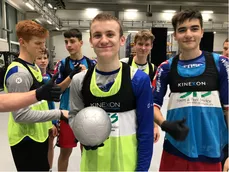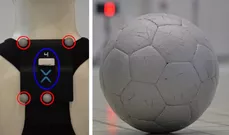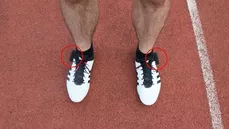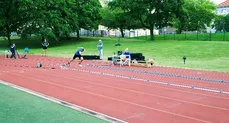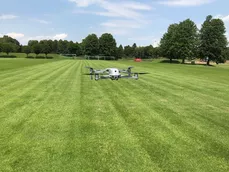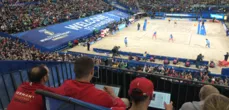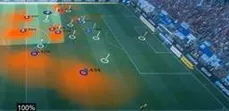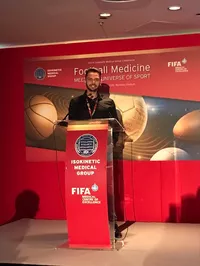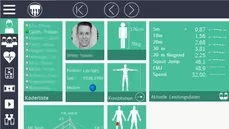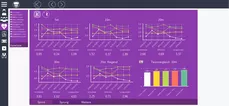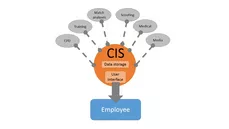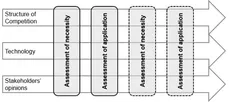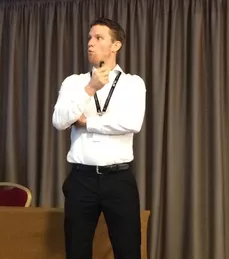- Validation of Player and Ball Tracking
- Acquisition of sprint parameters with inertial sensors (IMUs)
- Use of drones in sports - Position data and video for training and competition
- Keyplay analysis in badminton
- Competition analysis in taekwondo
- Competition analysis in beach volleyball
- New approaches for analyzing spatio-temporal data in sports
- Performance analysis in penalty kick in football
- Club information system (CIS) for top level football
- A Management Theory for Introducing IT-Innovations in Sports
- Evaluation of rules and Technological Officiating Aids in Game Sports
Validation of Player and Ball Tracking
Contact: Patrick Blauberger
This project is about the validation of position detection methods in sports. In a study in Nuremberg, the measurement of a local positioning system (LPS) was compared to motion capturing reference data. Therefore, athletes conducted a sport-specific course (SSC) and small sided football games (SSG), simultaneously tracked by both systems. Furthermore, football shots and handball throws were performed to evaluate ball tracking. The accuracy of the LPS represented the current state of the art for player and ball position detection in team sports. However, ball tracking showed a larger error than player tracking (see publication). In this context, the influence of the positioning of the sensor should be further reviewed.
Publications:
Blauberger, P., Marzilger, R. & Lames, M. (2021). Validation of Player and Ball Tracking with a Local Positioning System. Sensors, 21 (4), 1465. https://doi.org/10.3390/s21041465
Acquisition of sprint parameters with inertial sensors (IMUs)
Contact: Patrick Blauberger
The aim of the project "Sensor-based real-time running diagnostics in athletics", which was funded by the Federal Institute for Sports Science (BISP) in 2019, was to generate running-specific performance parameters, such as ground contact times, by viewing sensor-based inertial data. In a previous project, it was shown that distance-specific parameters (e.g. stride length) can be collected by simply measuring positions. Based on this, the possibility of a more comprehensive performance analysis should be developed through the additional consideration of data from inertial measurement units. The developed methodology has already been validated with the results of reference measurements (see publication). It turns out that, for example, ground contact times can be determined precisely. Consequently, there are further possibilities for performance diagnostics in the athletic disciplines.
Video:
https://www.youtube.com/watch?v=StSKHzlmG90
Publications:
Blauberger, P., Horsch, A. & Lames, M. (2021). Detection of Ground Contact Times with Inertial Sensors in Elite 100-m Sprints under Competitive Field Conditions. Sensors, 21 (21). https://doi.org/10.3390/s21217331
Use of drones in sports - Position data and video for training and competition
Contact: Dr. Tiago Russomanno
The goal of the project, “Use of drones in sports - Position data and video for training and competition”, funded by the Federal Institute for Sports Science (BISp) is to evaluate and validate the use of drone’s videos for position detection in sports for performance analysis. As we know drones are widely available in the consumer market and have been used for several different applications (e.g., agriculture, surveillance, sports broadcasting), most because they have high-quality video recordings, they are portable and very versatile compared to fixed cameras and offer an aerial perspective of the playing field that are suitable for broadcasting, position detection, and tactical analysis. In this way, we developed a video-based system using drones por performance analysis in different sports. As exemplary models we used Ultimate Frisbee, Football, and Tennis for performance analysis. Fist findings showed that the system was reliable for position detection in sports compared to GPS and LPS systems available in the market, providing X and Y position of players in the field with a good accuracy. This technology should help sports teams that do not have access to positional data in a regular basis, improving their performance based on positional data.

The goal of the project, funded by the German Federal Institute for Sports Science (BISp) (2020, 2021, 2021-22),lies in the analysis of the transition from a balanced to an unbalanced state in a badminton rally. Based on the theory of dynamic systems, in sports science situations like these are called perturbations. In sports practice it is often called keyplays. Artificial Intelligence procedures and algorithms should help to identify patterns which causes such perturbations. With these information we want to generate profiles of strengths and weaknesses of players. This should help the German National Team to enable a better preparation of future opponents. First findings of the project will be used in direct competition preparation of the Olympic Games 2021.
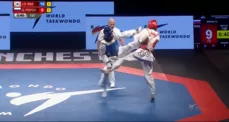
The aim of this project funded by the German Federal Institute for Sports Science (BISp) (2020, 2021-22) lies in the development and evaluation of two new competition monitoring tools for Taekwondo. The focus is on optimal IT support for the German Taekwondoins, especially with regard to the Olympics in 2021 and 2024. With the TaekScouter, event data can be collected parallel to the competition via a touch surface. A second annotation mode with greater data depth is available for subsequent analyzes. The TaekViewer is used for the analysis and presentation of event data and allows quantitative evaluations to be created and video material to be pre-structured for qualitative analysis.
The Chair of Performance Analysis and Sports Informatics has been supporting the German Volleyball Association (DVV) with game analysis in beach volleyball since 2010. In this, new methods for analyzing match data and software tools for analysts and trainers were developed. In the project "Analysis of the course of the game in beach volleyball" (2021), the existing software is extended in order analyze temporal patterns and behavioral dependencies during one set. The project “Beach Compiler - An Integrative Video Analysis” (2021-22) aims to develop software for video training sessions in beach volleyball. This enables German national coaches to create multimedia presentations on the strengths and weaknesses of upcoming opponents and to make them digitally available to the players before a competition. The project "Sequence decisions in beach volleyball: An integrative approach to psychological research and game observation" (2021-23) is carried out in cooperation with the Psychological Institute of the German Sport University Cologne (Prof. Dr. Dr. Markus Raab). The aim is to identify strategies of top level teams when making decisions in serving. All projects are funded by the German Federal Institute for Sport Science.
Publications:
Link, D., & Raab, M. (2021). Experts Use Base Rates in Real-world Sequential Decisions. Psychonomic Bulletin & Review. doi: 10.3758/s13423-021-02024-6
Promotion Video (World Champioship Hamburg 2019).
Recent years have seen developments in the field of sensor technology which led to a rapid increase in the volume of data. In particular, spatio-temporal position data, which are now available almost everywhere in soccer, harbor huge potential for performance analysis. However, these vast amounts of data have little value in themselves. Rather, the challenge is to develop new methods of data analysis, and to use the resulting structures and correlations in sports data to augment and enhance our knowledge about sport. The spectrum of analytical approaches ranges from simple classification methods, the theory of dynamic systems up to artificial intelligence. In this long-term project we develop and validate models and indicators to describe tactical structures in teams sports games and use them in performance analysis.
Publications:
Lang, S.; Wild, R.; Isenko, A.; & Link, D. (2022). Predicting the in-game status in soccer with machine learning using spatiotemporal player tracking data. Sci Rep 12, 16291. https://doi.org/10.1038/s41598-022-19948-1
Link, D., & Lang, St. (2019). How to Find Elementary Football Structures in Positional Data. In Football Analytics: Now and Beyond. A deep dive into the current state of advanced data analytics (pp. 50-65). Barcelona, Spain: Barca Innovation Hub.
Link, D. (2018). Data Analytics in Professional Soccer – Performance Analysis based on Spatiotemporal Tracking Data. Wiesbaden: Springer Verlag. doi: 10.1007/978-3-658-21177-6
Link, D., Lang, St. & Seidenschwarz, Ph. (2016). Real Time Quantification of Dangerousity in Football Using Spatiotemporal Tracking Data. PLoS ONE, 11(12): e0168768. doi:10.1371/journal.pone.0168768.
Performance analysis in penalty kick in football
Contact: Guilherme Pinheiro (guilherme.pinheiro@tum.de)
The analysis of penalty kick performance in football has played an important role in recent research. The average number of goals scored by both teams is typically low during regulation time in football matches (i.e., 2.5). As a consequence, the scoring opportunity that is provided by a penalty kick can decide the outcome of a match. In addition, during a decisive penalty shoot-out, the importance to the outcome of the match is even more obvious.
Researchers have approached the penalty kick from a variety of perspectives, including the application of mathematical models to predict penalty-kick performance outcomes, influence of different performance strategies, emotional pressure, the effects of an environment scaled to the body dimensions of the players, kinematic analysis for predicting outcomes or questionnaires. However, there is no scientific consensus about which performance indicators to use and which analysis tool to apply.
Therefore, the objective of this project is to (i) design and validation of an observational system applied to the penalty kicks regarding the aspects related to tactics and technique, (ii) distinguish the profile of successful and unsuccessful penalty kicks in elite football and analyze the key characteristics that demarcate penalty kick strategies, and (iii) validate new performance indicators. Through the observational system future evaluations will be possible, in order to identify the relation of age, gender and performance, also a wide comparative evaluation between players of different nationalities. The use of a reliable method may have implications for scientific researchers, performance analysts and coaches who seek to identify penalty takers’ likely strategy.
Guilherme Pinheiro (guilherme.pinheiro@tum.de)
PhD Stud. Sportwissenschaften
Technische Universität München
Fakultät für Sport und Gesundheitswissenchaften
Lehrstuhl für Trainingswissenchaft und Sportinformatik
KAAD - Katholicher Akademischer Ausländer-Dienst
Mitglied der UFMG Soccer Science Center (www.ufmgsoccer.com)
The aim of this study is the software development of a central club information system (CIS) for football clubs. In top level football (similarly in other sports) clubs there are different isolated sources of information, which are generated by different sub-systems and sub-organisations. There are different sources of information (such as club-management, public relations, team-management, medical, athletics… etc.) and every field has its own systems to generate and store this information (Lames, 1997). A Management information system (MIS), normally originating from economy, is used in this work to model a club information system for football clubs. That would mean that all employees in a club can have access to data that is relevant for them. Because there is only little knowledge about this topic, a research cooperation with two youth academies of a first league football club of the German Bundesliga has been started. At the example of performance analysis and medical data, the information system will be developed. Based on this concept, a prototype will be implemented and observed in a field test. A main target of this work will be the development of deeper analyses across different source systems and cross connections between data of different fields (performance analysis and medical).
Already existing systems:
The difference to already existing club information systems is, that the needs of employees and current scientific insights will be more considered. The User Interface is an important part of the software development, because this is one key factor for users to work with this software (and their data) or not. The development follows the purpose: Usability by Design. Therefore it is important, to have a software model, that allows to make changes in design, analysis and graphs as quick and easy as possible, without complex coding. Main aims of such a software model are: - Longterm and deep analysis - Complex filters - Cross-connections between data of different sources - Quick changes (in UI, graphs and analysis) - Integrating of (complex) scientific insights into football practice At the end of the implementation process there should be an operational software-model as prototype that could be used for further development. It could also be used by researchers to implement complex scientific knowledge into one tool. This would mean a big benefit for both sides (researchers and practician), because research would get a platform to present their (to one special field isolated) insights at a bigger platform and the knowledge becomes more practical.
Focus:
- User Interface
- Individual
- Appealing
- Usability by Design
- Longterm and deep analysis
- Filter (age groupe, field position…)
- Cross-connections between Data of different sources
- Quick changes (UI, Analyses…) - Integration of complex science into a tool for sport practice
- A tool to get insights at football practice and develop it (easily) further to fullfill the needs of employees in football clubs.
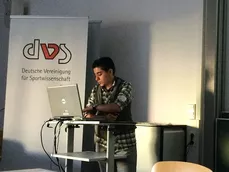
(22. Sportwissenschaftlicher Hochschultag)
Making the introduction of IT-Innovations in sports more efficient and effective by offering a management theory, that covers management and economical aspects of innovations (especially IT-innovations) in the setting of top level sport.
Innovations cause growth. Thanks to many researches, it is now obvious for us that innovations - especially technological innovations - led to advantages in top-level sports. Some of the IT technologies that have been improving training systems and brought competitive advantages in top-level sports are for example the advent of new procedures of object detection for analyzing playing positions, new generations of sensors and intelligent algorithms. But despite of all these endeavors, there is still a lack of a management theory and a general approach, which firstly can be used for every technological innovation, and secondly put top-level sports as the target group. According to the high rate of the environmental changes and increasing number of IT-Innovations, identification of the nature of the innovation, the best time for introducing, implementing and examining it given to its life cycle and rate of desired innovation diffusion and acceptability, and also identification of stakeholder’s needs for being able to satisfy them in time, can be most important aspects for extracting this management theory. For achieving this aim, it is necessary to deal in depth with the concepts of management approaches, top-level sports projects with the subject and content of IT-Innovations, and knowledge of all stakeholders behavior, expectations and the level of their roles in these projects. Mina Ghorbanizadeh is going to work on this kind of theory as her PHD dissertation and has presented it in the latest dvs-conference in Mainz.
Evaluation of rules and Technological Officiating Aids in Game Sports
Contact: Otto Kolbinger
The video assistant referee in football (VAR), automatic line-calling in tennis or revised regulations regarding headers in youth football – more and more sport associations adapt their rule books to broaden the appeal of competitions, increase player’s safety or to equip match officials with new tools to apply and enforce rules. All those interventions create the need for evaluations regarding two overarching questions: Before an intervention is introduced, one needs to assess its necessity. After the introduction, the focus is on investigating the effects of an intervention. Sport associations currently underestimate the multi-dimensional nature of a comprehensive evaluation process.
The introduction of the VAR in football exemplifies the lack of comprehensive evaluations of those interventions. Applying sentiment analysis to more than half a million of tweets, the chair could show that the VAR is affecting predominantly negative emotions by spectators, despite its positive influence on the overall decision accuracy. Further, associations tend to neglect interdependencies with other Technological Officiating Aids. Already in 2015, Kolbinger et al. raised concerns regarding the cost-benefit ratio of goal line technology and pointed out that the benefit will further shrink after the introduction of a video replay review system.
Besides such customized evaluation designs for specific interventions, the chair also provides universal concepts for the assessment of rule changes. As a main goal of his dissertation project, Dr. Otto Kolbinger developed a framework for the evaluation of Technological Officiating Aids in game sports. The underlying model describes the assessment of such interventions as a multi-disciplinary approach and on-going process (figure 1). For this model, investigating the structure of the competition, and therefore using methods and tools of performance analysis, is essential to estimate the necessity as well as the effects of an intervention. Since the start of this project, the chair was able to act as a main contributor to the discussion of the scientific community as well as to support intervention processes in collaboration with sport associations.
Selected publications:
Kolbinger, O. & Knopp, M. (2020). Video kills the sentiment—Exploring fans’ reception of the video assistant referee in the English premier league using Twitter data. PLoS ONE, 15(12): e0242728. doi.org/10.1371/journal.pone.0242728
Kolbinger, O. & Stöckl, M. (2019). Misbehavior During Penalty Kicks and Goalkeepers Holding the Ball Too Long as Trivial Offenses in Football. Frontiers in Psychology. 10:844. doi: 10.3389/fpsyg.2019.00844
